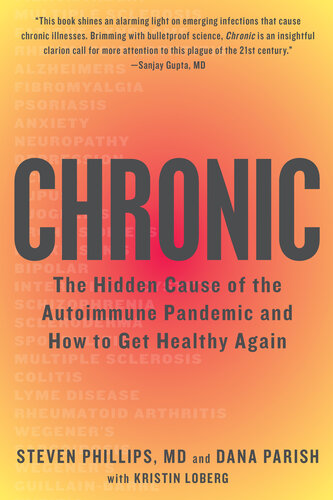
Chronic
The Hidden Cause of the Autoimmune Pandemic and How to Get Healthy Again
علت پنهان همهگیری خودایمنی و این که چگونه دوباره سالم شویمtseT
کتاب های مرتبط
- اطلاعات
- نقد و بررسی
- دیدگاه کاربران
نقد و بررسی

May 15, 2020
A doctor and his former patient explore what they posit is the pathogen-spread rise of autoimmune illnesses, with millions of victims. Diseases such as multiple sclerosis, lupus, rheumatoid arthritis, and fibromyalgia are not single illnesses as such but instead clusters of symptoms with many points in common. Because their etiology is hard to pin down, many sufferers are often dismissed with the simple notation that the illness is psychosomatic. Yet, writes Phillips, who suffers from a parasitic illness wrought by a spider bite, "maybe you were referred to a psychiatrist or prescribed an antidepressant by your general practitioner." For various reasons, he and Parish write, pathogens are on the rise and ever more ubiquitous as a result of climate change; these pathogens include viruses, parasites such as protozoa, and bacteria. By 2050, they project, 12% of the U.S. population will be affected by a kind of "Lyme+" disease, costing billions annually in medical expenses and lost productivity. The list of vector-borne ailments is long, and too often our understanding of them is incomplete. The authors write, for instance, that Lyme is not strictly a tick-borne disease but can be transmitted by fleas, lice, and even ants, "along with its stereotypical transmission via a cat scratch or bite." Apart from the fact that a spirochete is involved, everything else about Lyme is "bitterly debated," with no agreed-upon treatment regimen. What's worse, the range of illnesses that may be hidden by Lyme-like symptoms can include cancer, hepatitis, and tuberculosis. Phillips and Parish suggest a range of treatments, from anxiety-reducing exercises to herbal remedies such as oregano oil, cinnamon bark, and cumin seeds that have been shown to have "strong killing activity against 'persister' forms of the Lyme bacterium"--though none of those proposed treatments is definitive. An informative guide to what the authors call "the pandemic in plain sight," urgent without undue alarmism.
COPYRIGHT(2020) Kirkus Reviews, ALL RIGHTS RESERVED.

July 1, 2020
Physician researcher Philips and his patient Parish observe that conditions such as Lyme Disease mirror the "spreading pandemic" of chronic, inflammatory, autoimmune diseases, including multiple sclerosis, rheumatoid arthritis, lupus, fibromyalgia, and others (Lyme+), in which pathogens may play a causative role. Their book is based on Philips's long experience in treating vector-borne diseases (those caused by parasites, viruses, or bacteria that are transmitted by arthropods such as mosquitoes, ticks, and fleas), and Parish's experience living with Lyme disease. Lyme disease is still not easy to diagnose as lab tests are not completely reliable and current treatment, such as two to four weeks of antibiotic therapy, often leaves patients with lingering infection that creates chronic, sometimes severe, problems. And most patients who present symptoms with the other Lyme+ diseases seldom even get tested for parasites, viruses, or bacteria. Philips recommends broader testing and longer-term use of antibiotics (as much as a year or two), with occasional breaks when needed. VERDICT Not the mainstream approach endorsed by the American College of Physicians and other medical groups but a glint of hope to the many people living with Lyme+ diseases and those who treat them.--Marcia G. Welsh, Dartmouth Coll. Lib., Hanover, NH
Copyright 2020 Library Journal, LLC Used with permission.

























دیدگاه کاربران